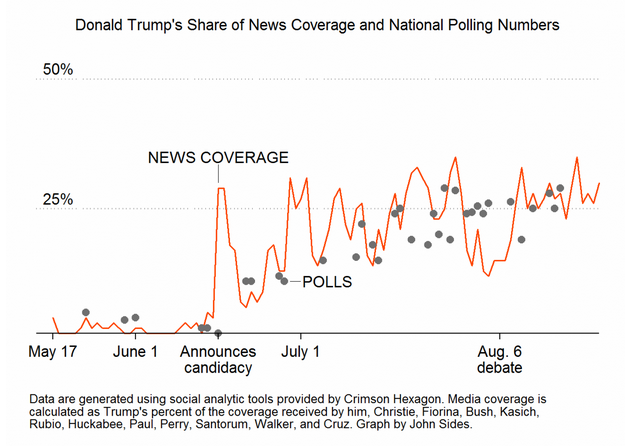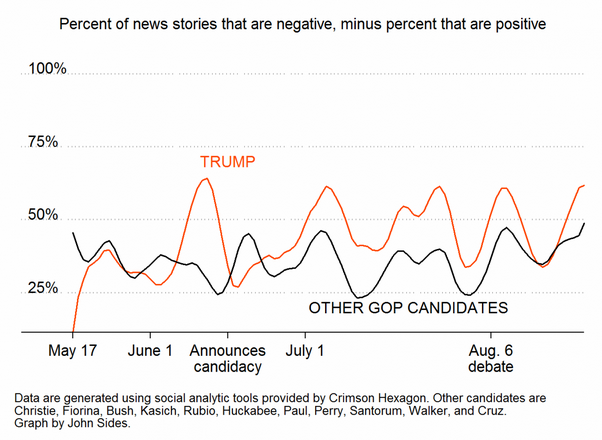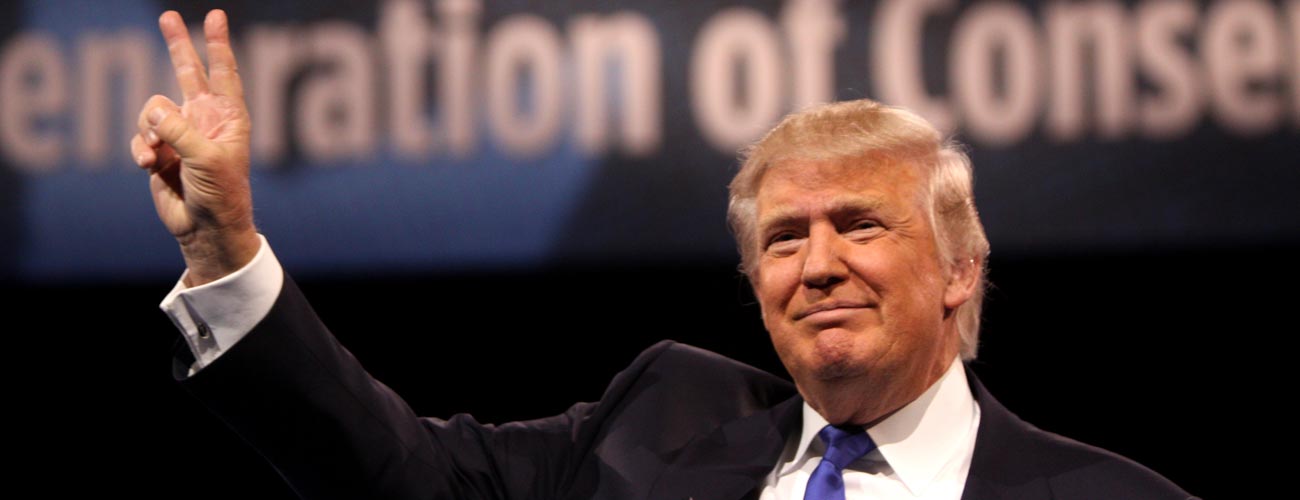Donald Trump was telling the truth. “It’s a simple formula in entertainment and television,” he explained before a crowd of thousands in Dallas last week. “If you get good ratings—and these aren’t good, these are monster—then you’re going to be on all the time, even if you have nothing to say.”
It was one of a handful of media critiques Trump spouted as he free-associated for more than an hour in front of rolling news cameras broadcasting live on cable and online. While the real estate tycoon has bragged repeatedly about his business savvy and personal fame en route to a lofty perch atop Republican primary polls, his real genius may lie in an understanding of the political media market unmatched by his competitors. For Trump, the press is not only the vessel to carry his self-centered message to millions, but also the foil in a readymade, “come-from-behind” storyline that few billionaires can rival.
“I haven’t heard the word ‘clown’ in a while—they don’t use that word anymore,” Trump told the crowd in Dallas. “They talk about us. They talk about me. And they said, Well … . But most of them are now saying, We think he’s going to win. Can you believe that?”
It is unbelievable, and that’s why Trump makes for especially entertaining campaign coverage. But Trump’s rise has been no accident. He’s a well-known political outsider who speaks in black-and-white proclamations, satisfying the media’s and the public’s shared craving for celebrity, novelty, and clarity. His dominance in the polls is as outlandish a story as any about his offensive remark du jour, and both draw swarms of reporters. When the press does attempt to hold Trump accountable, he parries and pivots to highlight his strengths, however abstract.
The ensuing free publicity has helped Trump save on TV ads in primary states, and he cashes in that exposure for mammoth—and newsworthy—rallies. His penchant to grab journalists’ attention has made it more difficult for opponents to gain the media exposure needed to challenge him, a difficulty accentuated by the GOP’s sprawling, politically diverse primary field. To quote the narrator of the appropriately absurd The Big Lebowski: “Sometimes, there’s a man, well, he’s the man for his time and place.”
The reality-star presidential candidate is now a reality for political media. And while there may be little hope for his White House prospects, there’s also little doubt that he continues to affect the campaign. The danger, as some political scientists and commentators argue, is that the outsized media attention Trump draws in fact creates political momentum for his campaign. Many journalists, on the other hand, have maintained their professional innocence, instead pegging his rapid ascent to popular anger toward the Washington establishment. Both are likely true to some extent. News organizations’ challenge going forward will be to solve an enigma that has consistently dogged them this summer: how to cover Trump in a media environment that so obviously suits him.
“There’s some mutual complicity [among media and voters],” National Journal columnist Ron Fournier says. “We in the media are definitely fueling his rise. But on the other hand, we in the media may burn him up … . We would not be doing our jobs if we were not giving him an inordinate amount of attention. He is the frontrunner.”
Trump’s blowhard improvisation, some of it bordering on self-parody, feeds both the 24-hour cable news hole and the nonstop social media meatgrinder. The two GOP primary debates, both of them featuring Trump center stage, combined to draw nearly 50 million viewers. His stream-of-consciousness Twitter presence boasts 4.3 million followers, and his tweets are routinely shared thousands of times. Though most media covered the candidate’s #AskTrump Q&A on Monday as a hilariously botched attempt at outreach, it was decidedly on-message for his narcissistic campaign. Former Obama communications director Dan Pfeiffer called it “a reminder that [he] is way better at the internet than anyone else in the GOP, which is partly why he is winning.”
Trump is entertaining at face value, sure. But that’s not the only reason the media and public tune in. Vanderbilt University political scientist Larry Bartels argued in his 1988 book, Presidential Primaries and the Dynamics of Public Choice, that reporters tend to give the most attention to unexpected winners or losers—“unexpectedness” being a very subjective measure. “As with any horse race,” Bartels wrote, “pre-race handicapping, a source of interest in its own right, serves as a benchmark against which actual results are measured.”
This is newsworthiness, in short, and Trump exudes it. His bid was characterized as a joke from the start, making his rise in the polls even more breathtaking. As MSNBC host Chris Hayes explained on Facebook, “It is the very definition of man bites dog, the old reporter cliché about what constitutes news.”
The question is whether Trump’s inherent newsworthiness has catalyzed a self-fulfilling prophecy of news coverage, popularity increases, and yet more news coverage. The first hurdle for primary candidates is making a political introduction to voters, and the news media remains the best avenue to share and receive this new information. Such “discovery” is the first of three coverage phases political scientists John Sides and Lynn Vavreck describe in their book, The Gamble: Choice and Chance in the 2012 Presidential Election. It’s typically followed by “scrutiny,” when reporters dig into candidates’ leadership qualities, policy agendas, and personal histories, followed by “decline.”
Sides and Vavreck contend that heavy media coverage pegged to events such as Rick Perry’s campaign announcement, Herman Cain’s Florida straw poll win, and Newt Gingrich’s strong debate performances in 2011 introduced them to voters and caused them to rocket up the polls. The candidates’ mini-surges came as establishment front runner Mitt Romney stagnated by comparison.
“Because Romney was relatively well-known, he never received the spikes in coverage that Perry, Cain, and Gingrich did,” Sides and Vavreck wrote. “Because of that, he never ‘surged’ in the polls and never experienced the reinforcing cycle of positive news coverage and gains in the polls. This made him appear to be a weak candidate, unloved by many in the party.”

Graphic by John Sides
Sides has argued repeatedly on The Washington Post’s Monkey Cage blog that this summer has seen a similar cause-and-effect relationship between Trump’s media coverage and polling position. “I’m not suggesting that there is no substantive appeal that a candidate like Trump might have,” Sides says in an interview. “He says things that many Republican voters agree with. But the information [they get] has to change first. People aren’t going to go out and change their minds for no reason.”
The difference between Trump and his 2012 predecessors lies in the balance of their media coverage, Sides says, positive versus negative. Perry, for example, saw increasingly harsh reporting after disastrous debate performances and news of his family’s “Niggerhead” hunting ranch. Cain, meanwhile, faced sexual harassment allegations. Such revelations are of course worth reporting, and following coverage eventually overwhelmed any inherently positive analyses of high polling numbers or rally attendance. “Discovery” became “scrutiny,” and then “decline.”
“With Trump,” Sides says, “you just don’t see that.” The business magnate does receive more negative coverage than his peers in the race. As Politico’s Jack Shafer points out, reporters have delved into Trump’s “divorces, his wild exaggerations, his bad business deals, his lobbying, his feuds, his college years, his high-school years, his wobbly grasp on public policy, his history as a birther and the rip-off that is Trump University,” among other topics. Despite such portrayals, says Democratic pollster Margie Omero, “He went from being completely unpopular with Republicans to being popular with them in two months … . That’s highly unusual for someone so well known and who’s been in the public eye for so long.”

Graphic by John Sides
Sides argues that appropriately negative stories have struggled to gain enough editorial momentum to trump (so to speak) the coverage of his polling numbers or rally attendance, which make up a more straightforward horse-race narrative. “And Trump tends to talk about those [polling] metrics himself as well,” Sides says. Look no further than his Twitter feed to see as much.
Headline reads” Rubio passes Bush in Florida poll” — Unfair, because Trump destroys them both! Trump 31.5%, Rubio 19.2%, Bush 11.3%
— Donald J. Trump (@realDonaldTrump) September 23, 2015
The other factor aiding in Trump’s media influence is the sheer size of the GOP primary race. A field of more than a dozen GOP candidates divides non-Trump coverage into very small slices, making it even more difficult for additional storylines to challenge Trump’s. The latter is comparatively easy to cover, with seemingly constant media availability and tantalizing off-the-cuff remarks. Dividing newsroom resources between the 15 or so more buttoned-up candidates is a tall task.
“He took up so much oxygen that other candidates became less able to make themselves known,” says the pollster Omero. “There’s less room for Scott Walker to introduce himself and gain traction. The percent of people who were unsure about Scott Walker went up [over the summer]. And that may be because he had less press coverage.”
Walker dropped out of the race this week after running a poorly managed campaign plagued by political missteps and wobbly debate performances. But it seems difficult to dispute that the traffic-driving Trump played at least some role by drowning out the Wisconsin governor’s “aggressively normal” message.
Still, as Fournier rightly points out, it would be journalistic malpractice to stop reporting on Trump. “We have an obligation to cover potential presidents,” he says. Indeed, not to mention an obligation to cover them seriously. The media’s early characterization of Trump as a clown has become one of his favorite themes during campaign rallies, packed by thousands who already distrust the press. Continued portrayals as such could only fuel the admittedly compelling tale that he is atop the polls despite having no business being there.
The polls, for all their faults, are among the few quantitative indicators of how the campaign is evolving at such an early stage. They’re also used to decide debate rosters. “You should report on polls,” says Matthew Dickinson, a presidential historian and political scientist at Middlebury College. “But put them into context.”
“Do so in a way that’s realistic,” Dickinson says. “They’re not very predictive in terms of outcomes … . For all the noise [Trump]’s making, he’s not doing much better than Rick Perry [at this point in 2011]. The difference is that you’ve got the remaining support split among 16 candidates.”
Dickinson and many others have argued that journalists should also challenge Trump more often on policy: How will you deport 11 million undocumented immigrants? How will you get factory jobs back stateside? How will you respond to ISIS? While many reporters have pushed back, Trump responds by embracing his lack of specifics. “I think the press cares, but I’ve never had a voter ask for my policy papers,” he told The New York Times.
In a hypercompetitive political media market, there are few traffic incentives for such dry, repetitive coverage, but there are plenty to highlight Trump’s most recent outrageous remark or latest poll result. What’s more, his proposals are scattered all over the political map.
“That both adds to his appeal—if you’re out there and paying half attention to the race, he’s your kind of Republican—but it’s also harder for the media,” Dickinson says. “It’s harder to place him within the field of candidates as a social conservative or libertarian or from-the-establishment. He’s just Donald The Great.”
David Uberti is a writer in New York. He was previously a media reporter for Gizmodo Media Group and a staff writer for CJR. Follow him on Twitter @DavidUberti.

